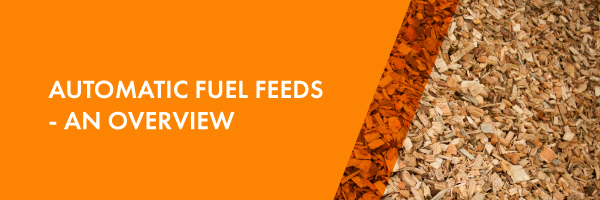Whilst it’s hard to compete with the compact size and ease of installation of a conventional fossil fuel boiler, making the choice to move to a carbon-neutral biomass boiler doesn’t need to be a painful one. Although the size of a biomass boiler is almost always larger than that of its typical fossil fuel counterpart, the years of innovation and leading engineering has provided a fuel feed system for almost every demand and now allow biomass boilers to be installed into even the most challenging of settings.
Below we’ve compiled a list of the most common elements of an automatic fuel feed system and we explain the best practices and maintenance requirements.
Fuel Extraction
There are 3 types of fuel extraction systems, these remove fuel from its store and transfer it to a fuel delivery system which in turn transports pellets or woodchips to a boilers combustion chamber.

Gravity fed (wood pellets)
The density of wood pellets (3 times that of wood chips) allows for an easier flow than its counterparts, making it suitable for gravity-fed extraction.
Pellets will flow down a 50-degree angle, so a variety of fuel stores will work:
Outdoor agricultural/bespoke silos
Indoor bagged silos
Purpose-built elevated indoor stores
A suction feed is most commonly used to transport pellets from a fuel store to a boiler hopper, this saves space and reduces pellet damage, reducing dust.
Fuel Delivery: Depending on accessibility, your fuel delivery would most commonly be blown or tipped into your storage space.




Walking Floor / Scraper Floor
A walking floor delivery system is a robust option made up of a steel grid and hydraulic rams. It extracts woodchip from a storage space by pushing the fuel along the store floor into an auger or chain conveyor which takes it to the boiler.
The walking floor solution is best suited to larger biomass boiler systems where large quantities of fuel need to be delivered consistently over long periods of time.
Fuel Delivery: The filling of a walking floor is typically done via a telehandler, so the method of woodchip delivery can vary dependent on your secondary storage and delivery schedule.

Spring / Sweep Arm Agitator
A Spring Agitator consists of multi leafed sprung steel arms connected to a rotating disk and gearbox. The agitator lies at the base of the fuel store floor which is built at an angle.
On larger systems, the agitator has a separate drive shaft and motor, but most commonly agitators are driven from an auger/screw feed. When the auger runs, delivering fuel to the boiler, the sprung steel arms of the agitator rotate, agitating the fuel within the store, causing it to fall into the path of an auger or conveyor feed.
Fuel Delivery: The method of Woodchip delivery is dependent on your fuel store accessibility. An auger or conveyor solution does not require gravity to aid the fuel’s journey to the boiler, so stores can be built meters below boiler level which can facilitate direct discharge of the chip from the delivery vehicle without any handling requirements.



Mechanical Fuel Delivery

Auger / Screw Feed
An Auger or Screw Feed transports fuel extracted from a store to a boiler. The auger, which commonly sits in a steel casing, is a screw-shaped part that rotates, carrying woodchip to boiler stoker screws and in turn, the combustion chamber. The auger is driven by a gear motor.
Auger feeds and their motors should be sized to best suit the fuel store extraction system, the distance from the store to boiler and the fuel quality.
Recommended Maintenance:
Regular Maintenance: A visual inspection of the auger should be carried out to ensure there are no blockages. Blockages can cause motor burnout as well as accelerated wear and tear of mechanical parts.
Specialist Maintenance: A trusted maintenance partner should undertake a thorough visual inspection of the motor and parts of the auger feed in order to spot early signs of issues. It is also recommended that you consult with your maintenance partner before a significant fuel quality change to discuss if any modifications are needed to keep fuel flowing and reduce motor burnout.
Direct Hydraulic Feeding Unit
Best suited to larger industrial biomass boiler systems, a Direct Hydraulic Feeding (DHF) unit is designed to transfer coarse materials. This is most commonly used in combination with a walking floor extraction system. A sensor monitors the level of the material within the DHF unit. The hydraulic scraper pushes fuel along using multiple ‘scrapers’ into the combustion unit.
Speak To The Bioenergy Specialists About The best Automatic Fuel Feeds | Contact The Team




